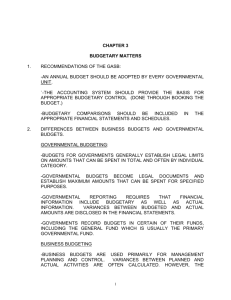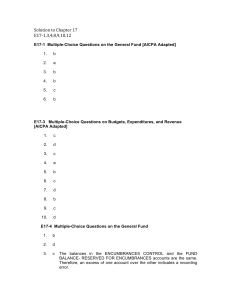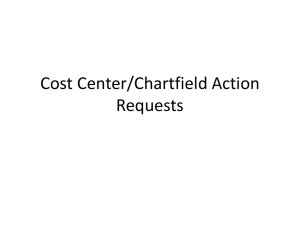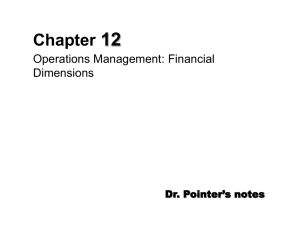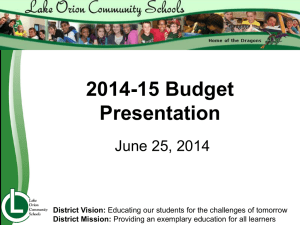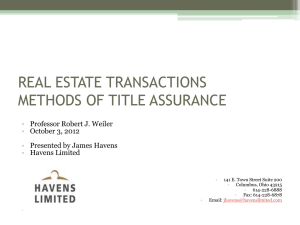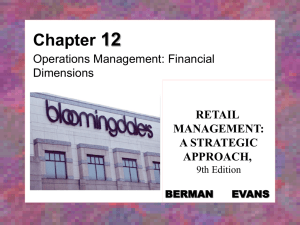Board Secretary Report Presentation
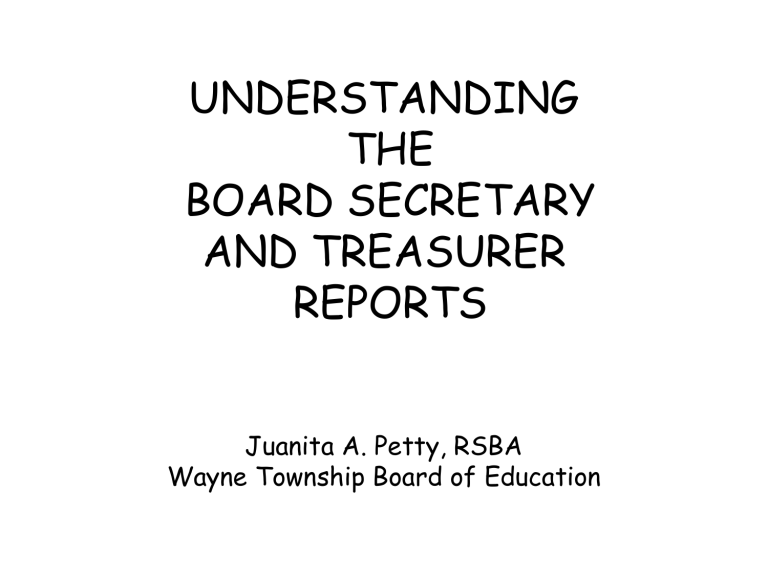
UNDERSTANDING
THE
BOARD SECRETARY
AND TREASURER
REPORTS
Juanita A. Petty, RSBA
Wayne Township Board of Education
PURPOSE
• To provide overall summary of financial activity and a picture of the District’s financial status
• To provide assurance that estimated revenues are being realized to support current operations
• To provide a better awareness of the budget-toactual status
• To monitor cash
• To ensure that the District’s accounting system is in balance
ACCOUNTING BASICS
ASSETS:
Items owned by the District
Normally have “debit” balances
Current Assets include:
• Cash
• Investments (NJ Cash Management, CD’s)
• Capital Reserve Account
• Maintenance Reserve Account
• Receivables (tax levy, tuition, state aid)
• Resources: Unrealized Revenues (estimated-actual revenues)
Basics continued
LIABILITIES:
Amounts owed by the District
Normally have “credit” balances
Current liabilities include:
• Accounts payable
• Contracts payable
• Those debts the District expects to pay within a year or less
ESSENTIAL LAWS OF
ACCOUNTING
DEBITS = CREDITS
ASSETS = LIABILITIES + FUND BALANCE
ASSETS – LIABILITIES = FUND BALANCE
FUND ACCOUNTING
* Fund 10 – General Fund
11: general current expense
12: capital outlay (items over $2K)
13: special schools
* Fund 20 – Special Revenue Fund
(entitlement grants)
Fund Accounting continued
* Fund 30 – Capital Projects Fund
(funds construction costs)
* Fund 40 – Debt Service Fund
(cashier to pay bond principal/interest)
* Fund 60 – Enterprise Funds
(food service, support services)
* Fund 90 – Trust and Agency Funds
REPORT ORGANIZATION
• Interim Balance Sheet
• Interim Statements comparing budgeted revenue with Actual-to-date and
Appropriations with Expenditures and
Encumbrances-to-date
• Schedule of Revenues – Actual Compared with Estimated
• Statement of Appropriations Compared with Expenditures and Encumbrances
INTERIM BALANCE SHEET
Contains two sections:
Assets and Resources Section
Liabilities and Fund Equity Section
REMEMBER:
Assets/Resources MUST EQUAL Liabilities + Fund Equity
Balance Sheet Accounts
Asset Accounts
101 Cash
102-106 Cash Equivalents (petty cash)
111 Investments
116-118 Reserve Accounts
121 Tax Levy Receivable
132 Interfund Receivable
141
142
Intergovernmental Receivable – State
Intergovernmental Receivable – Federal
143 Intergovernmental Receivable - Other
153 Other Receivables
Balance Sheet Accounts
Liabilities Accounts
411 Intergovernmental Accounts Payable – State
421 Accounts Payable
Fund Balance Accounts
753 Reserve for Encumbrances – Current
754 Reserve for Encumbrances – Prior
761 Reserved Fund Balance – Capital Reserve
770 Unreserved Fund Balance
Assets :
Report of the Board Secretary
For the Month: _________
Cash
Investments
Capital Reserve
Receivables
Total Assets :
1,000
100
5,000
0
6,100
Liabilities :
Fund Balance :
Total Liab + FB :
Accts. Payable
Res. For Encumbr.
Unreserved
500
2,100
3,500
6,100
INTERIM STATEMENTS
Provide the first layer of detail of the amounts shown in the general ledger budgetary control account balances. There are two parts:
Revenues Section – budget estimated, actual, over/under, and unrealized balance
Expenditures Section – appropriations, expenditures, encumbrances, and available balance
Revenue Statement
• Contains “summarized” information as of date of report
• Budget Estimated Column is the budgeted amount, including revisions (adjusted budget)
• Actual Column is actual amount recognized to date
• Over/(Under) Column reflects whether actual to date is greater than or lesser than budgeted
• Unrealized Balance Column shows the difference between the budgeted and actual amounts
Positive amount – will still be recognized
Negative amount – actual has exceeded the budgeted amount
Expenditures Statement
• Contains “summarized” information as of date of report
• Presented at function level – same as advertised budget
• Appropriations Column reflects budgeted amount, including revisions (adjusted budget)
• Expenditures Column reflects the expenditures when purchase orders are closed and paid
• Encumbrances Column reflects outstanding commitments, either open orders or contracts
• Available Balance Column is the balance left after the
Expenditures Column and Encumbrances Column are subtracted from the Appropriations Column (uncommitted amount; funds available)
Detail Statements
Schedule of Revenues
Contains detail of Interim Revenue
Statement
Statement of Appropriations
Contains detail of Interim Expenditures
Statement
Variations to Report
• Reports for other Funds (Special Revenue
20, Capital Projects 30, Debt Service 40) are more summarized
• They do not include Interim Statements
Balancing Details
• Total Assets MUST equal total liabilities + fund balance
• Actual revenues, expenditures and encumbrances MUST match on all sections of the report
• Revenue Account (302) = Total of Actual Revenue
• Encumbrances (603) = Reserve for Encumbrances (753/4)
• Encumbrances (603) = Total Encumbrances on the Expenditure
Report and Open Purchase Order Report
• Expenditure Account (602) = Total Expenditures on Expenditure
Report
Timelines
• Secretary Report
• Treasurer Report monthly monthly
• Recommended timeline – example:
Bank statements received beginning of October for month of September. Reports would be submitted to
Board for approval at the end of October
Nonconformance to this timeline results in an audit recommendation
What if it’s not in balance?
• Transaction may be have posted to the wrong Fund
• If you’ve done a journal entry, you may have to do the transaction through the budget, revenue or purchase order module rather than the general ledger
• If you’ve added a new account in your general ledger, you must ensure that it is properly set up to reflect in your
Board Secretary’s Report
• Check to be sure all reports were run at the same time and on the same date
• Electrical problems could create a surge that affected a transaction as you posted it
Treasurer Report
• Basically a monthly bank reconciliation
• Details cash receipts and cash disbursements
• Includes all Governmental Funds – 10, 20,
30 and 40
• Includes Enterprise Funds (60)
• Includes Trust and Agency Funds (90)
Format of Report
Three Sections:
• Governmental Funds
• Enterprise Funds
• Trust & Agency Funds
Four Columns:
• Beginning Cash Balance
• Cash Receipts This Month
• Cash Disbursements This Month
• Ending Cash Balance
Funds
Fund 10
Fund 20
Fund 30
Fund 40
TOTAL
Fund 60
Payroll
Agency
Report of the Treasurer
For the Month: ___________
Beginning
Cash Balance
5,000
100
1,000
Cash
Receipts
1,500
100
2,000
Cash
Disbursement
400
50
1,000
5,000 5,000 0
11,100 8,600 1,450
500 100
0 10,000
0 5,000
500
10,000
3,800
Ending Cash
Balance
6,100
150
2,000
10,000
18,250
100
0
1,200
Reconciling to Secretary Report
• Compared on Fund by Fund basis
• Ending Cash Balance on Treasurer Report MUST equal Cash and Cash Equivalents on Secretary’s
Report
• For Fund 10, also include Investments and
Reserve Accounts in cash total
What if they don’t match?
Similar to balancing your checkbook…
• Verify timing differences – make sure all deposits are recorded in the correct period; otherwise, detail as deposits in transit
• Verify outstanding checks to be sure they are included or have been removed if cleared by the bank
Matching cont’d
• Make sure that interest has been posted during the period
• Be sure to verify that a transaction was not posted to the wrong Fund
